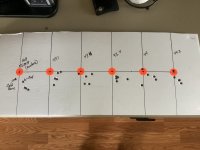I’m sorry if I don’t understand what you’re telling me…is that good or bad and which load would you work with…. This is very interesting to me
The theory of OCW is to achieve a powder charge weight that results in a POI that is insensitive to powder charge or environmental induced variations (mainly temperature) or minor variations in powder lots. More powder = higher velocity, less powder = less velocity. For temperature sensitive powders, higher temperature mimics higher powder charge, lower temperature mimics lower powder charge.
Looking at only POI differences, your results are good. The combo you have has a very large and forgiving window. Most scopes can't dial 0.03 MRAD, so theoretically you'd never have to readjust your zero once set if you choose a powder charge somewhere in the middle of 43.1 and 44gr. Of course you should retest the entire range just to confirm that the center of the groups remain true to your initial test.
If you just want a wide range window of powder charges that you don't have to mess with adjusting your zero, you can choose exactly 43.55gr of powder, which is in the middle of the 43.1 to 44gr range which allows you to have a powder charge variation (crappy powder measure, sloppy loading, etc) that is +/- 0.45 grain of powder or have temperature swings that mimic +/- 0.45gr difference in velocities, and you theoretically will have no more than a 0.03 MRAD center of group shift from your original zero.
Now this doesn't mean your results will give you the smallest overall group sizes nor does it give you the most consistent group.
For consistency in group sizes, you look into group size SD (Variation) as well as the group size mean. The smaller the differences between charges in a range the better. For your results, that is 43.1gr to 43.4gr, with a SD variation of about 0.34" and a mean difference of 0.172" (43.4gr with a mean of 1.26" minus 1.088" which is the mean of 43.1gr) .
If you wanted to choose this range, to confirm, you would load 43.1, 43.25, and 43.4gr and retest for similar center POI (of primary importance in OCW), consistency in group size mean and SD. If confirmed, you would aim to load 43.25gr of powder every time and your charge variance allowed is +/- 0.15gr.
If you take a look at 43.7, yes it produced the smallest group mean, but on either side (43.4 or 44), the groups grow larger by roughly 0.45". So theoretically any change that is equivalent to +/- 0.3gr of powder (temperature extreme or otherwise) from 43.7 will result in your group size increasing by up to 0.45".
It all depends on what you want to accomplish. If you need velocity for external ballistics reasons, you select the powder charge that gives you the velocity you need but also is resistant to changes in point of impact, however, it might not consistently have tight groups.
If you want consistency in group sizing and not have to wonder why one range session your groups are 0.4 moa but your next session you can't get better than 0.6 moa, then you potentially select a narrower window which provides little to no POI shift and has consistency in group sizing. Your ability to consistently load ammo with good quality components and using temperature insensitive powders is paramount to achieving consistency with a narrower range. Any variable that induces changes that puts you out of that narrow window and your results may end up unacceptable to you.



